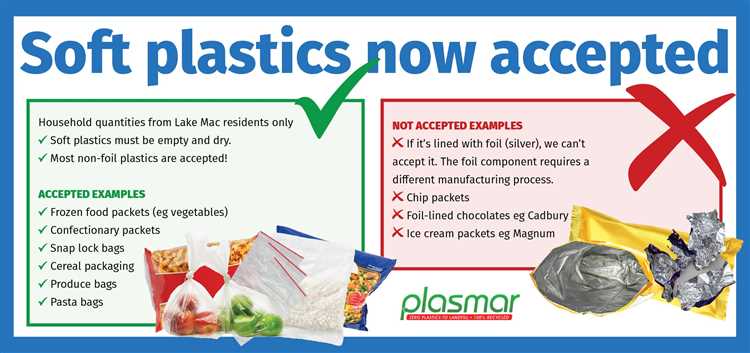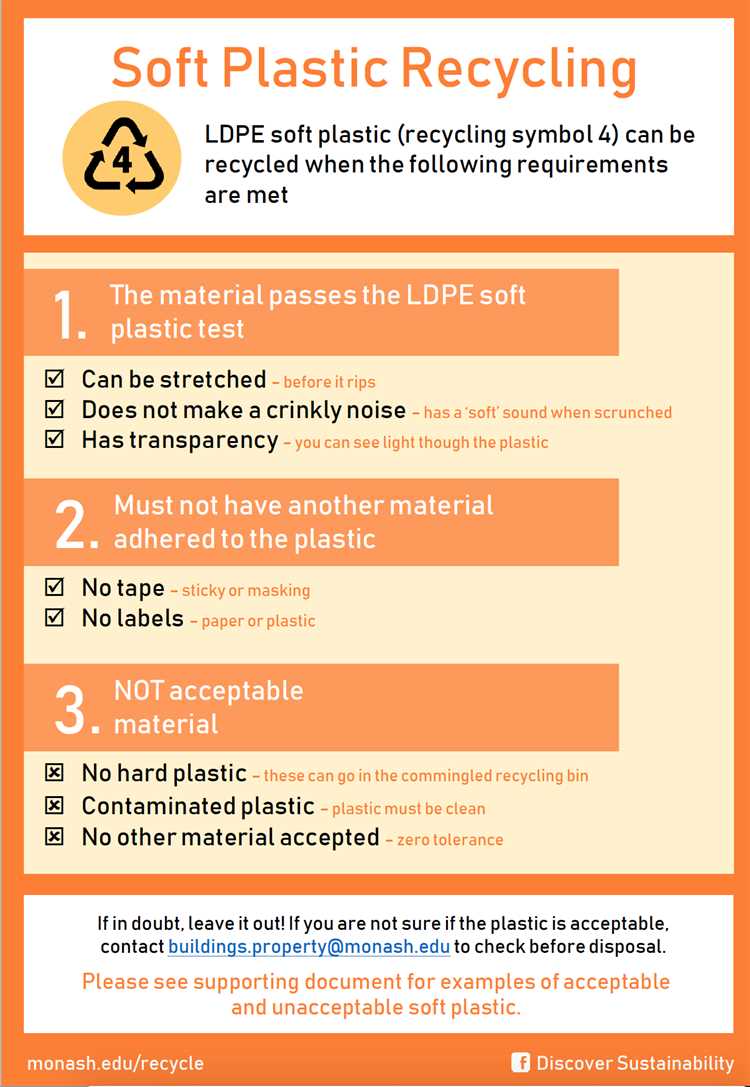Recycling is a crucial step towards reducing plastic waste and preserving our environment. However, not all types of plastics can be recycled, especially when it comes to soft plastics. Soft plastics are commonly used for packaging and can often be found in our daily lives, but unfortunately, many of them cannot be recycled.
Soft plastics are known for their flexibility and stretchability, which makes them useful for wrapping products or creating bags and films. They are typically made from low-density polyethylene (LDPE), which is a type of plastic that can be easily stretched and molded. However, LDPE is not always accepted by recycling facilities due to its properties and the challenges it poses during the recycling process.
One example of a soft plastic that cannot be recycled is plastic film or plastic wrap. This includes items such as cling film, plastic bags used for groceries or packaging, and bubble wrap. These types of soft plastics cannot be recycled because they tend to clog recycling machines, making the process difficult and inefficient. Additionally, their thin and stretchy nature makes it challenging to sort and separate them from other recyclable materials.
Another common soft plastic that cannot be recycled is food wrappers or pouches. These include items such as chip bags, candy wrappers, and single-serve food pouches. Food wrappers often have multiple layers of different materials, such as plastic, foil, and paper, which makes them difficult to separate and recycle. Additionally, these types of soft plastics can be contaminated with food residue, making them unsuitable for recycling.
It is important to note that while these soft plastics cannot be recycled through curbside programs, there are alternative ways to dispose of them responsibly. Some grocery stores and supermarkets have collection bins specifically for soft plastics, so you can drop off your plastic bags and film for proper disposal. Additionally, you can minimize the use of soft plastics by choosing reusable alternatives, such as cloth bags or beeswax wraps, whenever possible. By being mindful of the types of soft plastics that cannot be recycled and taking steps to reduce their usage, we can all contribute to a more sustainable future.
- Single-use plastic bags
- Alternative options to single-use plastic bags
- Proper disposal of single-use plastic bags
- Plastic film wrap
- Bubble wrap
- Plastic food packaging
- Q&A:
- Can all types of soft plastics be recycled?
- What are some examples of soft plastics that cannot be recycled?
- Why are some soft plastics not recyclable?
- What should I do with soft plastics that cannot be recycled?
Single-use plastic bags

Single-use plastic bags are a common type of soft plastic that cannot be recycled in most recycling facilities. These bags are typically made from a type of plastic called low-density polyethylene (LDPE), which is not easily recyclable due to its low melting point and lack of market demand for the recycled material.
When single-use plastic bags are sent to recycling facilities, they often get tangled in the machinery and cause operational issues. Additionally, the thin and lightweight nature of these bags makes them difficult to sort and process effectively. As a result, many recycling programs do not accept single-use plastic bags and encourage consumers to use reusable bags instead.
To reduce the environmental impact of single-use plastic bags, some municipalities and countries have implemented bans or fees on their distribution. This has led to an increase in the use of reusable bags, which are more sustainable and can be made from materials such as cotton or durable plastics that are accepted for recycling.
Alternative options to single-use plastic bags
There are several alternatives to single-use plastic bags that are more environmentally friendly. Some of these options include:
- Reusable cloth bags made from natural fibers such as cotton or jute
- Durable plastic bags made from materials such as high-density polyethylene (HDPE) or polypropylene (PP) that can be recycled
- Paper bags made from recycled materials
By choosing these alternative options, individuals can help reduce the amount of plastic waste generated and protect the environment.
Proper disposal of single-use plastic bags
If single-use plastic bags are not accepted for recycling in your area, it is important to dispose of them properly to minimize their impact on the environment. Some options for proper disposal include:
- Using them as trash can liners instead of purchasing new plastic bags
- Bringing them to designated drop-off locations that accept plastic bags for recycling
- Reusing them for future shopping trips or other purposes
By taking these steps, you can help ensure that single-use plastic bags are managed responsibly and do not end up in landfills or polluting natural ecosystems.
| Advantages | Disadvantages |
|---|---|
| Convenience for carrying groceries and other items | Contributing to plastic pollution and environmental damage |
| Low cost for retailers | Not easily recyclable in most recycling facilities |
| Lightweight and compact for storage | Can cause operational issues in recycling machinery |
Plastic film wrap
Plastic film wrap, also known as plastic cling wrap or plastic cling film, is a thin, flexible plastic material commonly used for wrapping food items to keep them fresh. However, plastic film wrap cannot be recycled in most curbside recycling programs.
The main reason why plastic film wrap is not accepted in recycling programs is that it is made from a different type of plastic than what is typically accepted. Most plastic film wrap is made from low-density polyethylene (LDPE), which is not easily recyclable through conventional means.
Another reason why plastic film wrap is not recyclable is that it tends to get tangled in the recycling equipment, causing a disruption in the recycling process. This can lead to costly repairs and delays in recycling operations.
While plastic film wrap may not be recyclable in curbside programs, there are some specialized recycling facilities that accept it. These facilities have the necessary equipment to process and recycle plastic film wrap effectively.
If you are unable to find a recycling facility that accepts plastic film wrap, it is essential to dispose of it properly. Plastic film wrap should be placed in the regular trash bin instead of being thrown in the recycling bin. Be sure to empty and rinse off any food remains before disposing of the plastic film wrap.
To reduce the amount of plastic film wrap you use and dispose of, consider using alternative methods of food storage. Reusable containers and beeswax wraps are excellent alternatives to single-use plastic film wrap and can help reduce plastic waste.
Bubble wrap

Bubble wrap, a type of plastic packaging material commonly used for cushioning fragile items, is not typically accepted for recycling. This is primarily due to the fact that bubble wrap is made from a low-density polyethylene (LDPE) plastic, which is not widely recyclable.
While some recycling facilities may accept bubble wrap, it is important to note that it is often considered a contaminant in the recycling process. The air-filled bubbles and the different layers of plastic make it difficult to separate and process efficiently. Additionally, bubble wrap is prone to getting tangled in recycling machinery, which can lead to costly damage and downtime.
However, it is worth noting that some recycling programs may offer drop-off locations specifically for bubble wrap, or may accept it as part of mixed plastics recycling. It is always a good idea to check with your local recycling facility for specific guidelines and restrictions.
If bubble wrap is still in good condition, consider reusing it or donating it to local businesses or individuals who may have a need for it. There are also some eco-friendly alternatives to bubble wrap available on the market, such as biodegradable bubble wrap or packaging materials made from recycled paper or cardboard. These options can offer similar protection for fragile items while reducing environmental impact.
Plastic food packaging
Plastic food packaging, such as bags, wraps, and bottles, is a common type of plastic that cannot be recycled in most curbside recycling programs. The main reason for this is that plastic food packaging is often contaminated with food residue, which can contaminate other recyclable materials and make them unrecyclable.
Furthermore, plastic food packaging is often made from different types of plastic that are not easily recyclable. For example, many food bags and wraps are made from low-density polyethylene (LDPE), which is not typically accepted by recycling facilities. Additionally, plastic bottles used for food products like juice or cooking oils may be made from a type of plastic called polyethylene terephthalate (PET), which can be recycled but is not always accepted due to the difficulty in separating it from other plastics.
Another challenge with recycling plastic food packaging is the presence of multi-layered packaging. Many food packages are designed with multiple layers of different types of plastic or with a layer of plastic and a layer of aluminum. These materials are difficult to separate and recycle, making the entire packaging unrecyclable.
While plastic food packaging may not be recyclable in traditional recycling programs, there are some alternative recycling options available. Some grocery stores and plastic film manufacturers offer collection programs specifically for plastic food packaging. These programs collect and recycle plastic bags, wraps, and films that are clean and dry. It’s important to check with your local recycling facilities or visit websites to find out if these programs are available in your area.
| Type of Plastic | Status in Recycling Programs |
|---|---|
| Low-density polyethylene (LDPE) | Not usually accepted |
| Polyethylene terephthalate (PET) from food bottles | Accepted in some programs |
| Multi-layered packaging | Unrecyclable |
In conclusion, plastic food packaging is often not recyclable due to contamination, different types of plastics used, and multi-layered packaging. However, there are specific collection programs available in some areas that accept and recycle clean and dry plastic food packaging. It’s important to research and inquire about these programs to ensure responsible disposal of plastic food packaging.
Q&A:
Can all types of soft plastics be recycled?
No, not all types of soft plastics can be recycled. There are some types that are not accepted in recycling programs.
What are some examples of soft plastics that cannot be recycled?
Examples of soft plastics that cannot be recycled include plastic bags, cling wrap, bubble wrap, and disposable gloves.
Why are some soft plastics not recyclable?
Some soft plastics are not recyclable because they have a different composition or are not accepted by recycling facilities due to low demand or contamination issues.
What should I do with soft plastics that cannot be recycled?
Instead of recycling, you can find alternative ways to reuse or dispose of soft plastics properly. For example, plastic bags can be reused for shopping or donated to local stores that have plastic bag recycling programs.